Recent Articles
Popular Makes
Body Types
2022 Volvo XC40 Road Test and Review
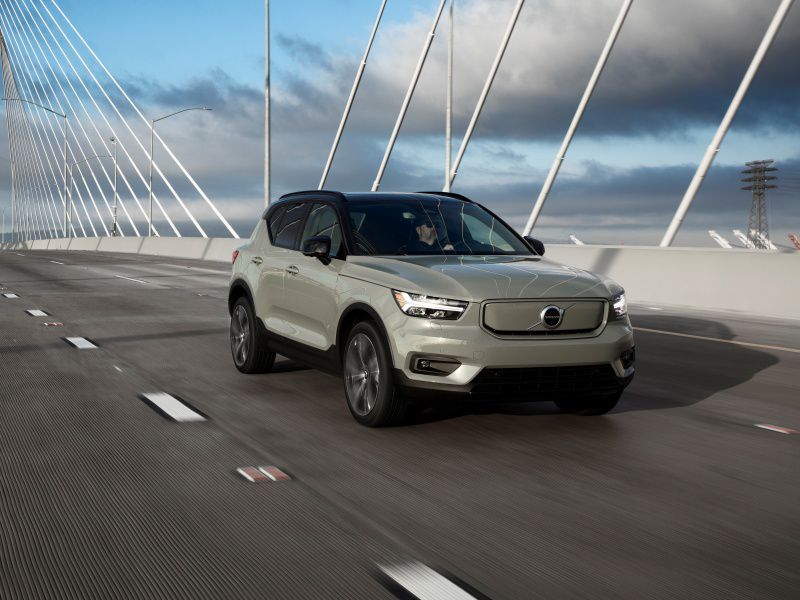
2021 Volvo XC40 Recharge ・ Photo by Volvo
The luxury compact crossover segment is one of the biggest luxury segments in the American market, and the Volvo XC40 is one of the key players. Volvo has infused the five-passenger crossover with distinctive styling, a strong safety orientation, and the availability of an innovative battery-electric version to make a big splash with luxury buyers. The XC40’s base model has a turbocharged 4-cylinder engine powering the front wheels, while other versions offer all-wheel-drive, a more powerful engine and, at the top of the line, an all-electric version. No matter which trim is chosen, the XC40 has delivers a leading-edge collection of electronic safety and driver-assistance features plus an interior that is both ergonomically sound and very pleasing to live in. There are many reasons singles, couples, and those with young children are flocking to the Volvo XC40. Here is our road test and review of the 2022 Volvo XC40.
Exterior Style
The typical “two-box” crossover utility profile doesn’t lend itself to differentiation. That is why so many compact crossovers essentially look alike. But the Volvo XC40 definitely breaks that mold. Its roofline and side window treatment are two elements that are especially distinctive. The XC40 is taller than many of its competitors, and this gives it several advantages. It is easy to get in and out of, and behind the wheel, the driver is elevated for a commanding view of the road ahead. Designers of the XC40 have managed to avoid the overwrought, over-sized grilles that have been a staple in the luxury segment for the past few years. Instead, the XC40 has a tasteful grille with an updated version of the familiar Volvo logo and a demure version of the diagonal highlight. In many ways, the rear of the vehicle is more expressive with its large L-shaped taillights flanking the rear hatch.

Photo by Volvo
Interior Design
The XC40 is one of the least expensive vehicles in Volvo’s lineup, but the interior doesn’t look the least bit downscale. While certainly not as plush at the interior of the XC90 midsize three-row SUV, the XC40’s cabin is still a well-styled, comfortable haven. In the Volvo tradition, it goes very light on extraneous ornamentation and is minimalist without seeming stark or cold. Even the base Volvo XC40 Momentum trim has leather seats, 8-way adjustable power driver’s seat with memory, 60/40 split-folding rear seatbacks, remote keyless entry with proximity key, and remote start. The XC40 carries on the Volvo tradition of offering some of the best, orthopedically designed seats in the industry. As one climbs the trim ladder in price, the level of luxury also climbs with the availability of natural-finish real wood trim and even an Orrefors crystal shift knob. The Volvo features some inventive storage areas, and natural fabrics are a New Age alternative to leather.
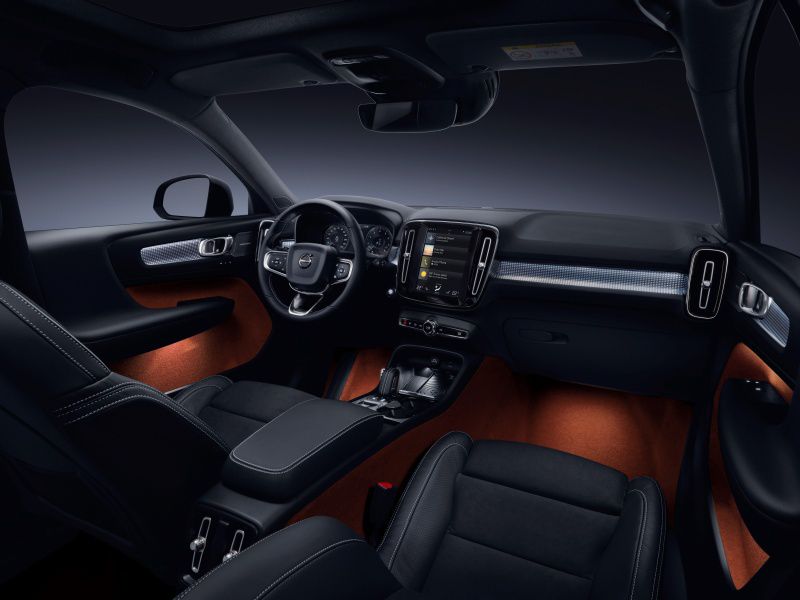
Photo by Volvo
Infotainment &Technology
The Volvo XC40 models offer modern infotainment systems, but the conventionally powered versions have a different infotainment system than the battery-electric Recharge. Befitting its status as the Volvo brand’s current technology stalking horse, the XC40 Recharge is fitted with the newest infotainment system. Building upon Volvo’s lengthy association with Google, the system is Android-based. It offers direct integration with Google Maps and Google Assistant, which makes its voice control functions among the best in the industry. Non-Recharge XC40s feature the Volvo Sensus infotainment system with a 9-inch touchscreen interface. It uses the familiar Volvo “multi-tile” layout for clarity and ease of use. Navigation, Apple CarPlay, and Android Auto are all standard. The Sensus system isn’t as intuitive to use as some competitive systems, including the system in the XC40 Recharge, but over time, it becomes relatively easy to use. Baby Boomers might miss AM radio, but the system does have a Wi-Fi hotspot. For those seeking upscale sound, Volvo offers XC40 customers a 13-speaker, 600-watt Harman Kardon system that includes an air-ventilated subwoofer.
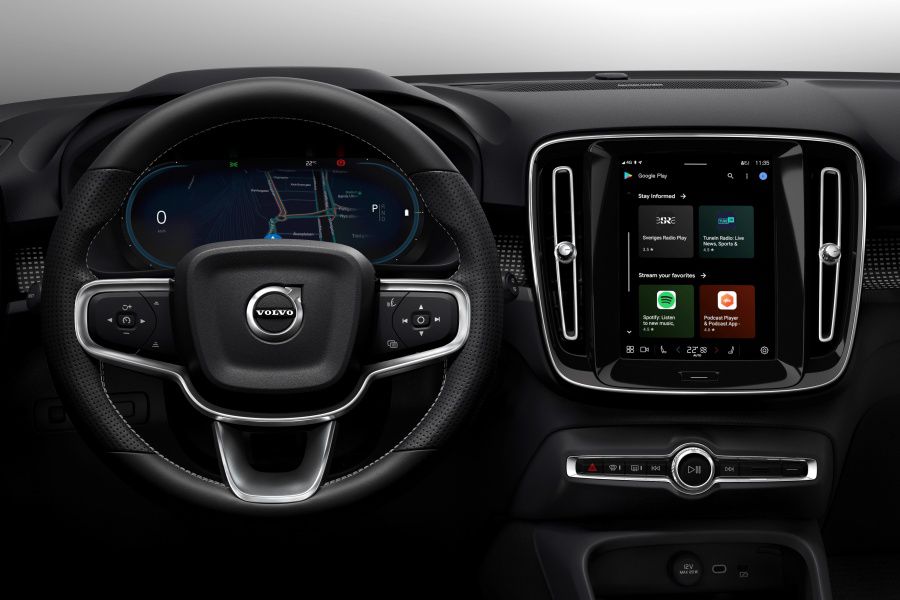
Photo by Volvo
Powertrains
You have to hand it to Volvo — the company does develop some interesting powertrains. The XC40 offers two conventional gasoline-fueled drivetrains and, of course, the battery-electric XC40 Recharge. The XC40’s base powerplant is a turbocharged 2.0-liter four-cylinder T4 that produces 187 horsepower and 221 lb-ft of torque. The T5 powertrain — a 2.0-liter four-cylinder as well — develops 248 horsepower and 258 lb-ft of torque. Both powertrains use 8-speed automatic transmissions. One big plus for the current powertrains is they are simpler than the turbocharged-and-supercharged offerings that some previous Volvos have had. From a price, features, and powertrain standpoint, the XC40 Recharge could almost be regarded as a separate model. Its two-motor drive system delivers 402 horsepower and instant peak torque, more than twice as much horsepower as the base T4. All XC40 Recharge models are all-wheel drive. XC40 models with the T4 powertrain are front-drive while the T5 versions have all-wheel drive.
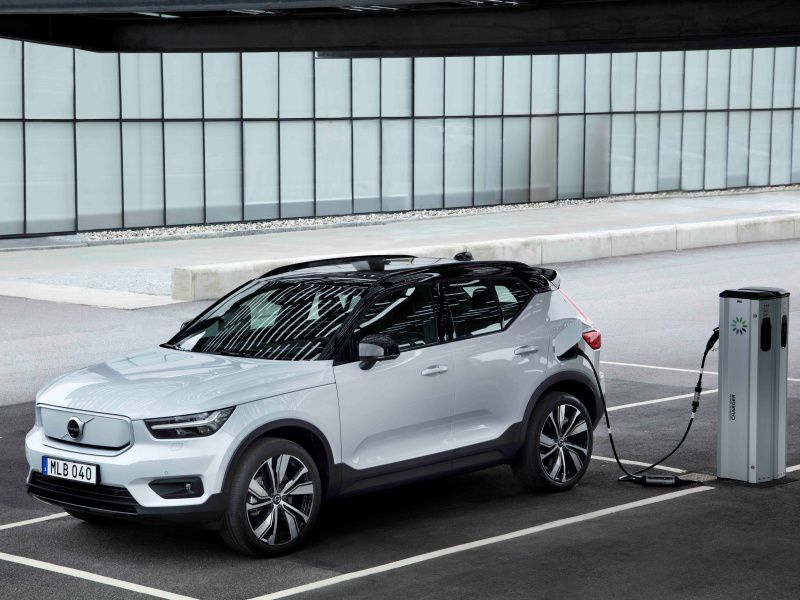
Photo by Volvo
Driving Impressions
Typical luxury crossover drivers will be perfectly happy with the performance of the XC40 with the base T4 powerplant. Those who seek a little more pep in their step will prefer the driving demeanor of the higher-powered T5. Then there is the utterly different feel of the XC40 Recharge with its 402 electric-motor horsepower. The Recharge is the quickest of the models, vaulting from zero to 60 miles per hour in less than 4.5 seconds. Still, for those seeking sporty looks to go along with their performance powertrain, the T5 R-Design trim will be their choice. It certainly cuts a sporty figure with its special black-insert grille and 19-inch matte black alloy wheels. At the same time, it is two seconds slower to 60 mph than the Recharge. Every one of the XC40s offers comfortable seating and plenty of luggage space for five passengers. With a relatively long wheelbase for its length, it is very pleasant on the highway. Equipped with a 75 kWh battery pack, the XC40 Recharge has an EPA-estimated range of 223 miles on a full charge.

Photo by Volvo
Safety & Driver Aids
Volvo goes the extra mile to retain its reputation as vehicle safety leader. And the Volvo XC40 demonstrates that. The 2022 XC40 has a long list of active safety and driver-assist features perhaps, the most prominent of which is City Safety. The system includes all of the Volvo’s collision-avoidance technologies that include collision warning with automatic braking, pedestrian and cyclist detection, large animal detection, and oncoming traffic collision mitigation. The Volvo Pilot Assist is a hands-on-the-wheel system that enables semi-autonomous steering, acceleration, and braking. It is operable on highways at speeds up to 80 mph. The XC40’s electronic systems are bolstered by a long list of other safety features that include crush zones and the strategic use of high-strength steels. The National Highway Traffic Safety Administration has awarded conventionally powered XC40s five stars, the highest honor in the 5-Star Safety Rating program. It has yet to rate the XC40 Recharge. The Insurance Institute for Highway Safety has given the 2022 Volvo XC40 its Top Safety Pick+ rating, the highest award.
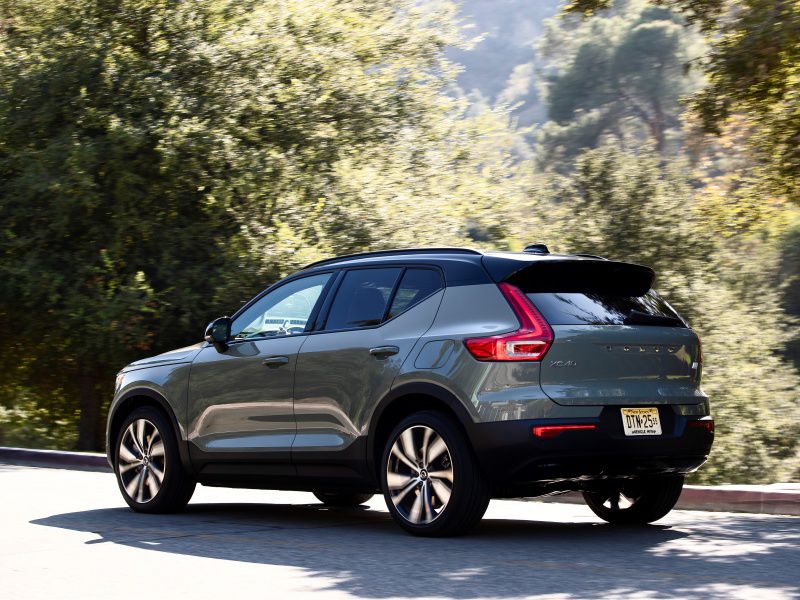
Photo by Volvo
Interior Space & Cargo Carrying
With its upright stance, the Volvo XC40 looks like it should have more cargo-carrying capacity than its luxury-crossover rivals, but that’s not the case. The XC40 has 21.7 cubic feet of luggage space in gasoline-fueled versions, while the XC40 Recharge offers that space plus front trunk area of 1.0 cubic feet, perhaps enough for its charging cord. The XC40’s cargo space compares well to the competitive Mercedes-Benz GLA, but it doesn’t measure up to the room in the BMW X1 or Audi Q3. With its rear seat folded down, the maximum cargo space in the XC40 is 46.9 cubic feet, about one cubic foot less than the Audi Q3. A properly equipped XC40 is rated tow up to 3,500 pounds.
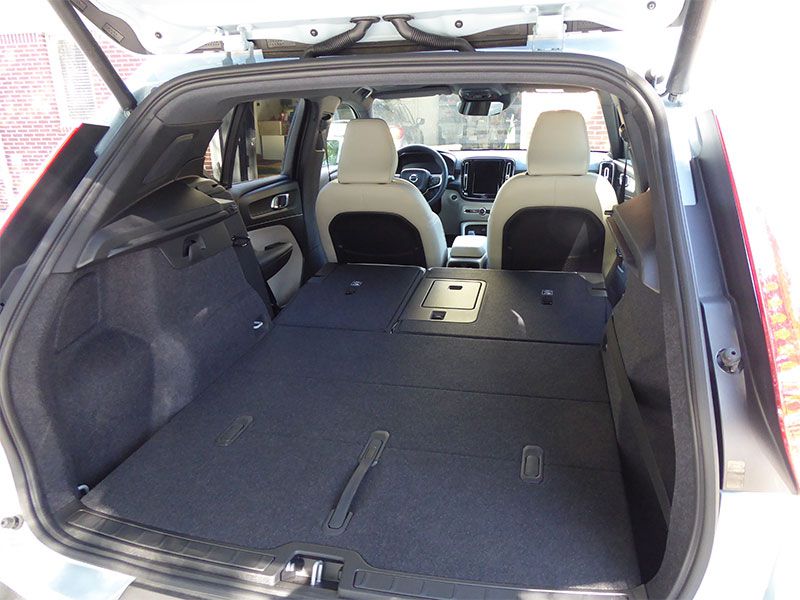
Photo by Ron Sessions
Fuel Economy
When it comes to fuel economy numbers, the gasoline-powered Volvo XC40 versions trail some competitors. But of course, the battery-powered Volvo XC40 Recharge is a zero-emission vehicle that delivers excellent fuel economy equivalency. The Environmental Protection Agency (EPA) says a front-drive XC40 with the turbocharged 2.0-liter T4 four-cylinder engine delivers an estimated 23 mpg city and 32 mpg highway with a combined rating of 26 mpg. With the T5 engine and all-wheel drive, the XC40 is rated at 22 mpg city/30 mpg highway. In comparison, an Audi Q3 is EPA-rated at 23 mpg city/30 mpg on the highway. The BMW X1 is rated at 24 mpg city/33 mpg highway. The battery-electric XC40 Recharge has an EPA rating of 92 MPGe in city driving and 79 MPGe on the highway. According to the EPA, it has an expected range of 223 miles on a full charge. In everyday driving, typical XC40 owners won’t notice much difference between the fuel economy of the conventional XC40 and competitive compact luxury crossover models. On the battery-electric side of the ledger, the Tesla Model Y is the only real luxury-brand competitor right now, but others are on the way.
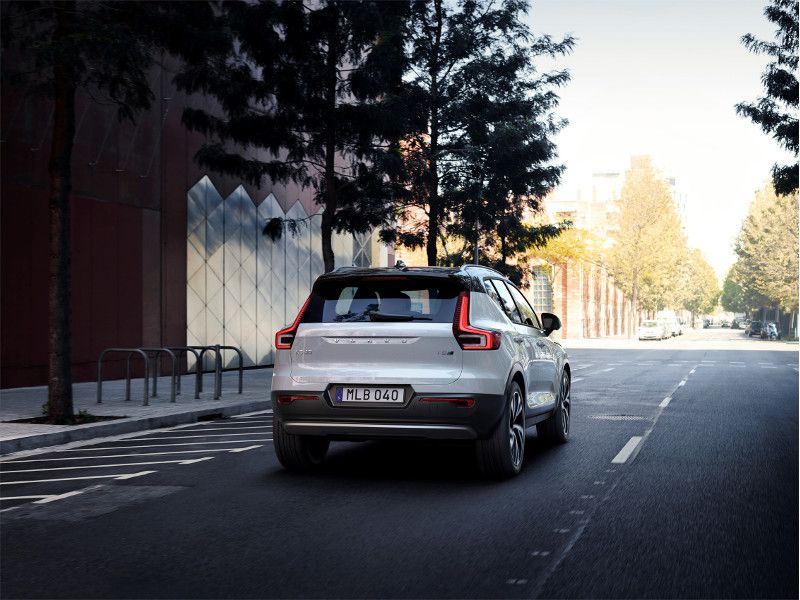
Photo by Volvo
Pricing & Value
The compact luxury SUV segment is highly competitive, and the Volvo XC40 can more than hold its own in overall value. The base front-drive XC40 Momentum T4 has a suggested retail price of around $36,000. The R-Design is the sportiest of the XC40s at least by looks. The Inscription is the most luxurious model in the lineup. Each of those trims can be purchased with the T4 front-drive powertrain with base prices slightly above $40,000. The T5 engine and accompanying all-wheel-drive add about $2,000 to the suggested price. We think there is plenty of value in the conventional XC40s. The XC40 Recharge is much more expensive, but the expense is justified by its all-electric architecture and its more modern infotainment system. The least-expensive XC40 Recharge has an MSRP of about $53,000. Heavily equipped versions can run over $60,000. Of course, many buyers will qualify for the maximum $7,500 federal tax credit that will lessen the price somewhat.

Photo by Volvo